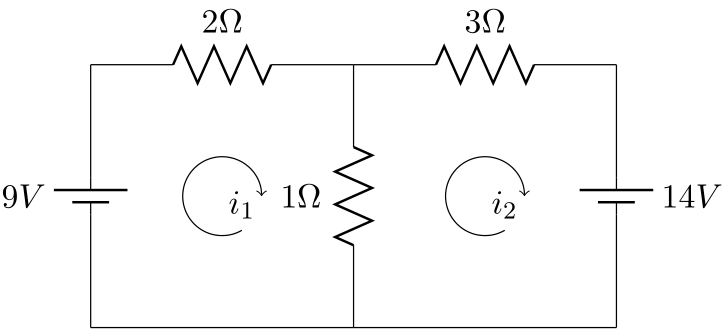Science:Math Exam Resources/Courses/MATH152/April 2016/Question A 11
{{#incat:MER QGQ flag|{{#incat:MER QGH flag|{{#incat:MER QGS flag|}}}}}}
• QA 1 • QA 2 • QA 3 • QA 4 • QA 5 • QA 6 • QA 7 • QA 8 • QA 9 • QA 10 • QA 11 • QA 12 • QA 13 • QA 14 • QA 15 • QA 16 • QA 17 • QA 18 • QA 19 • QA 20 • QA 21 • QA 22 • QA 23 • QA 24 • QA 25 • QA 26 • QA 27 • QA 28 • QA 29 • QA 30 • QB 1(a) • QB 1(b) • QB 1(c) • QB 1(d) • QB 2(a) • QB 2(b) • QB 2(c) • QB 2(d) • QB 3(a) • QB 3(b) • QB 3(c) • QB 4(a) • QB 4(b) • QB 4(c) • QB 4(d) • QB 5(a) • QB 5(b) • QB 5(c) • QB 5(d) • QB 6(a) • QB 6(b) • QB 6(c) •
Question A 11 |
|---|
|
Solve for the loop currents and in the circuit below. |
|
Make sure you understand the problem fully: What is the question asking you to do? Are there specific conditions or constraints that you should take note of? How will you know if your answer is correct from your work only? Can you rephrase the question in your own words in a way that makes sense to you? |
|
If you are stuck, check the hint below. Consider it for a while. Does it give you a new idea on how to approach the problem? If so, try it! |
Hint |
|---|
|
Consider Kirchoff's laws. Keep in mind that both and contribute to the current through the 1 resistor. |
|
Checking a solution serves two purposes: helping you if, after having used the hint, you still are stuck on the problem; or if you have solved the problem and would like to check your work.
|
Solution |
|---|
|
By Kirchoff's voltage law, the sum of the voltage drops across the left and right loop must be zero. This leads to the equations
We solve this system using row reduction. This system is represented by the augmented matrix . We add of the first row to the second row: . Now, we multiply the second row by : . We add the second row to the first row: . Finally, we divide the first row by 3: . Therrefore, we get that and that . We now verify that this answer makes sense. The direction of is opposite the direction of the current, because the current is running from high voltage to low voltage. Therefore, we expect that should be negative and should be positive. This is confirmed by our calculations. Answer: |
{{#incat:MER CT flag||
}}





![{\displaystyle \left[{\begin{array}{cc|c}3&-1&9\\-1&4&-14\end{array}}\right]}](https://wiki.ubc.ca/api/rest_v1/media/math/render/svg/2c92d898ca06114c3731e2f32ec9a4ca5b8653be)

![{\displaystyle \left[{\begin{array}{cc|c}3&-1&9\\0&11/3&-11\end{array}}\right]}](https://wiki.ubc.ca/api/rest_v1/media/math/render/svg/fd5abd2a97c96bc6e969a8afb8a9db0ff52f82f0)

![{\displaystyle \left[{\begin{array}{cc|c}3&-1&9\\0&1&-3\end{array}}\right]}](https://wiki.ubc.ca/api/rest_v1/media/math/render/svg/5517a3caf6a994fdf326f98a5eb73e368ecef71d)
![{\displaystyle \left[{\begin{array}{cc|c}3&0&6\\0&1&-3\end{array}}\right]}](https://wiki.ubc.ca/api/rest_v1/media/math/render/svg/76d0d76bd5dcbec31bada8d90e7b33c8d93e4ea6)
![{\displaystyle \left[{\begin{array}{cc|c}1&0&2\\0&1&-3\end{array}}\right]}](https://wiki.ubc.ca/api/rest_v1/media/math/render/svg/2339b4227485cfd269ddeb2b47e00126fa5dcfba)



